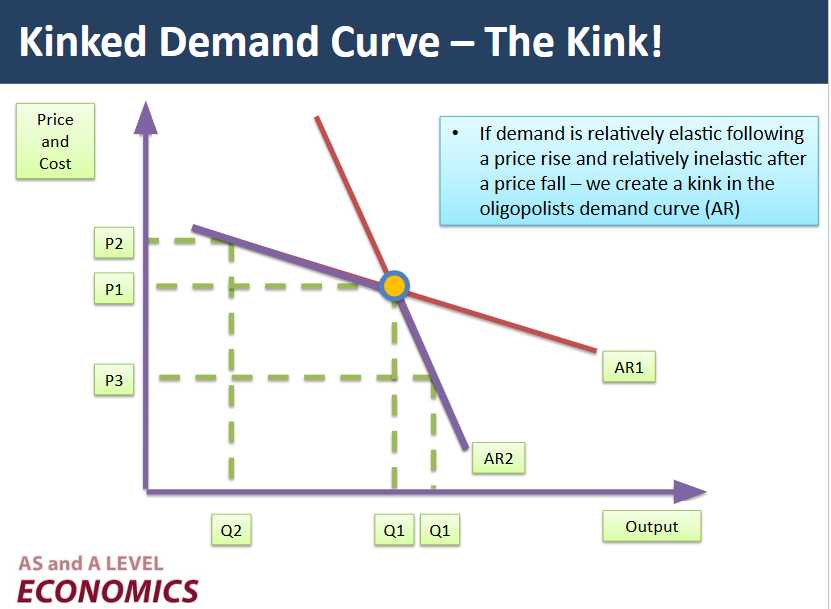4.4 Oligopoly
1/12
There's no tags or description
Looks like no tags are added yet.
Name | Mastery | Learn | Test | Matching | Spaced |
|---|
No study sessions yet.
13 Terms
Oligopoly
-A market in which there are just a few firms that dominate the market.
-Each firm will take decisions in close awareness of how other firms in the market may react to their actions.
Non-price competition
A strategy whereby firms compete by advertising to encourage brand loyalty, or by quality or design, rather than on price
Interdependence
Each firm in the market can affect the market, making firms decisions dependent on other firms
Product differentiation
The process of distinguishing a product or service from others, to make it more attractive to a particular target market. A strategy firms adopt that marks their product as being different from their competitors
Characteristics of an Oligopoly
-Best defined by the actual behaviour of firms. Objectives may not be profit maximise
-A market dominated by a few large firms
-High market concentration ratio
-Each firm supplies branded products
-Barriers to entry and exit
-Interdependent strategic decisions by firms
Advantages of non-price competition
-Price stability: Non price competition leads to price stability
-Better Quality: Products may have extra features or good after sale service in order to increase sales
-Advertising: Advertising provides consumers with information about products
-Consumer loyalty: Loyalty is encouraged and rewarded through gifts etc
Concentration ratios
Measures the market share of the largest firms in an industry. For example, the three-firm concentration ratio measures the market share of the largest three firms in the market
Formula for concentration ratio
Total sales of the top x number of firms x 100
sales of entire market
Strategic Interdependence
-Since there are few sellers, each firm is likely to be aware of the actions of the others.
-Decisions of one firm influence, and are influenced by, the decisions of other firms
-This causes oligopolistic industries to be at high risk of tacit or explicit collusion which can lead to allegations of anti-competitive behaviour
-In oligopoly there is a high level of uncertainty
-Non-price competition is a marketing strategy in which one firm tries to distinguish its product or service from competing products on the basis of attributes like design and workmanship
Kinked Demand Curve
-The price elasticity of demand may depend on the likely reaction of rivals to changes in one firm’s price and output
-Rivals are assumed not to follow a price increase by one firm, so the acting firm will lose market share - therefore demand will be relatively elastic and a rise in price will lead to less revenue
-Rivals are assumed to be likely to match a price fall by one firm to avoid a loss of market share. If this happens demand will be more inelastic and a fall in price will also lead to a fall in total revenue

Collusion
A form of anti-competitive behaviour. It is where firms base their decisions on the decisions other firms make. It refers to combinations, conspiracies or agreements among sellers to raise or fix prices and to reduce output in order to increase profits:
-Overt collusion – occurs when firms formally agree to not compete on price. It is legal when achieved through strategic alliances but illegal if achieved through price fixing
-Tacit collusion- when firms do not come to a formal agreement but simply observe the actions of their competitors and base their pricing decisions on what the competitors do. Often leads to sticky prices. (legal)
-Cartel - an agreement between firms on price and/or output with the intention of maximising their joint profits (illegal)
Advantages of an Oligopoly
-Oligopolies may adopt a highly competitive strategy, in which case they can generate similar benefits to more competitive market structures, such as lower prices. Even though there are a few firms, making the market uncompetitive, their behaviour may be highly competitive.
-Oligopolists may be dynamically efficient in terms of innovation and new product and process development. The super-normal profits they generate may be used to innovate, in which case the consumer may gain.
-Price stability may bring advantages to consumers and the macro-economy because it helps consumers plan ahead and stabilises their expenditure.
-SNP’s can be re-invested to create new jobs
Disadvantages of an Oligopoly
-High concentration reduces consumer choice. There is a potential loss of economic welfare
-Cartel-like behaviour reduces competition and can lead to higher prices and reduced output.
-Given the lack of competition, oligopolists may be free to engage in the manipulation of consumer decision making. Firms can be prevented from entering a market because of deliberate barriers to entry.
-Allocatively inefficient – firms are making SNP’s. Also, firms able to successfully collude will set prices higher than MC.
-Firms can be so large they suffer diseconomies of scale
-Firms may not be incentivised to reduce costs – x-inefficiency